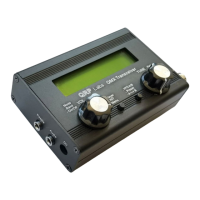This parameter enables CW decoding while editing. When YES, anything you key during editing of
NUMBER or TEXT type configuration parameters, edits the parameter. This is a really useful
feature that makes it very easy to enter frequencies or stored messages, for example.
SK or VA
VA
This parameter only controls whether the SK/VA prosign character, when decoded, is shown as
“SK” (this setting is OFF) or displayed as “VA” (this setting is ON).
The proper definition of this prosign character is somewhat disputed; some people believe
passionately that it is SK, others that it is VA. For the sake of universal harmony this parameter
therefore lets you choose your preference.
5.13 Digi interface
This menu contains settings relevant to the PC/QMX interface during Digital mode operations.
VOX
OFF
If you want to use VOX (Voice Operated Transmission) then set this parameter to ENABLE. Any
incoming audio from the PC will then operate the Transmit/Receive switch and be transmitted.
When the audio stops, QMX will switch back to Receive automatically. The problem with this is
that any system sounds on your PC, if the PC is configured to deliver these to the QMX USB
sound card, will operate the transmitter and be transmitted.
The default setting “DISABLE” requires a CAT command from the PC host application (WSJT-X
for example) in order to enable the transmitter. This is discussed in this manual in the section on
setting up WSJT-X for QMX
If you wish to use software that does not support CAT Transmit/Receive switching, this may be
one reason why you would want to enable VOX.
If using VOX, you will also need to disable the CAT timeout feature (see below).
The Voice Operated Transmit (VOX) function is not normally used. Normally you will wish
to connect WSJT-X (for example) via CAT to the QMX Virtual COM serial port.
Rise threshold
80
QMX operang manual; rmware 1_00_012 27

